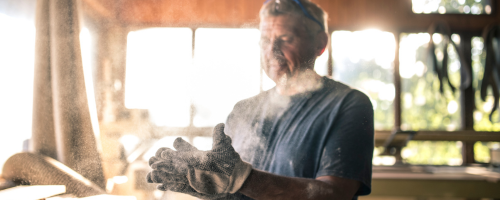Silica dust – The invisible workplace hazard
Workplace safety is something most of us take for granted, but for thousands of workers, everyday exposure to hazardous substances can have long-lasting and life-changing consequences. One such danger is respirable crystalline silica (RCS), a fine dust produced when cutting, grinding, or drilling materials like concrete, stone, or clay.
While workplaces are required to limit exposure to this dust, recent research suggests that current safety limits may not be enough to protect workers from silicosis – a severe and often debilitating lung disease.
The risks of Silica dust
Silica is naturally found in many materials used across industries, from construction to jewellery making. When these materials are processed, tiny silica particles can become airborne and inhaled. Over time, these particles settle in the lungs, causing inflammation, scarring, and ultimately, silicosis. Symptoms can include persistent coughing, shortness of breath, fatigue, and, in severe cases, respiratory failure. Unfortunately, the disease often develops slowly, meaning workers may not notice the effects until years after exposure.
People who work in these industries are most at risk:
- stone masonry and stone cutting – especially with sandstone
- construction and demolition
- worktop manufacturing and fitting
- pottery, ceramics and glass manufacturing
- mining and quarrying
- sand blasting
Globally, efforts have been made to limit silica exposure. In the UK, the Workplace Exposure Limit (WEL) for respirable crystalline silica is currently set at 0.10 milligrams per cubic metre (mg/m³). Internationally, permissible exposure limits (PELs) vary: the USA uses 0.05 mg/m³, France also sets 0.10 mg/m³, while China allows limits up to 0.35 mg/m³ depending on the industry. These limits are designed to reduce risk, but research indicates they may not be sufficient for lifelong protection.
What the latest research shows
A recent study, following Chinese miners and pottery workers over a period of more than four decades, highlights the real-world risks of long-term silica exposure. Even when exposure levels were at or below current international limits, the risk of developing silicosis increased over time.
The study found that after 40 years of exposure, the likelihood of developing silicosis was 7.25% at 0.05 mg/m³, 8.34% at 0.10 mg/m³, and 13.04% at 0.35 mg/m³. These figures may seem modest at first glance, but when applied to large workforces, they represent thousands of individuals facing serious health challenges. Even low-level exposure, considered “safe” by current standards, carries a material risk of disease over a lifetime.
Industries facing hidden dangers
The risk isn’t uniform across all industries. Traditional sectors such as mining or ceramics are well-known for silica hazards and typically have strong safety protocols. However, emerging or re-emerging industries are showing concerning patterns. For instance, artificial stone fabrication, denim finishing, container welding, and jewellery polishing have all been linked to silicosis outbreaks.
Small operators in particular can be at risk. Limited budgets, inconsistent use of protective equipment, and poor ventilation mean that even nominally “low” exposure levels can become dangerous. Case studies in the UK have highlighted young workers developing rapid-onset silicosis in small artificial stone workshops, where early detection measures were insufficient to prevent serious disease.
While exposure to silica is the primary concern, the research also underscores the impact of lifestyle and behaviour on disease risk. Smoking, for example, increases susceptibility across all exposure levels. This means that workers who smoke are at an even higher risk, making protective measures and health education particularly important.
Compliance issues
One of the most striking findings of recent studies is that simply adhering to workplace limits is not a guarantee of safety. Even when exposure falls within legal limits, workers may still accumulate enough silica in their lungs over decades to develop silicosis. This challenges the assumption that compliance automatically equates to protection, and underscores the need for employers to go beyond the minimum standards.
Enhanced controls could include stricter exposure limits, improved ventilation systems, wet cutting techniques to reduce airborne dust, regular health monitoring, and mandatory respiratory protection. Workers should also receive training on the risks of silica exposure and the importance of following safety protocols.
Support for those affected
For those who have been exposed to silica dust, especially in workplaces where protection was inadequate, it is essential to know that compensation may be available. If you have developed silicosis or another work-related lung condition, or if you suspect exposure may have occurred, we can provide expert guidance. Our team specialises in helping clients understand their rights and pursue claims where negligence or insufficient safety measures have contributed to illness.
Workplace diseases like silicosis can have devastating effects on quality of life. Beyond the physical toll, the financial and emotional impact on individuals and families can be significant. Legal action can help secure compensation for medical treatment, lost earnings, and other related expenses. Importantly, it also reinforces the need for stronger workplace protections, helping prevent others from facing similar risks.
If you are currently working in an environment where silica dust may be present, it’s vital to take proactive steps. This includes using appropriate personal protective equipment, ensuring your workplace has adequate ventilation, and attending any health screenings offered by your employer. Keep records of exposure and any health symptoms, as this information can be crucial if you later seek legal advice or compensation.
For former workers, particularly those who spent many years in industries such as construction, mining, or manufacturing, early detection is key. Silicosis can develop years after exposure, so regular check-ups with a respiratory specialist can identify problems before they become severe.
How NV Legal can help
Navigating claims for occupational illnesses can be complex. We have extensive experience supporting clients affected by workplace exposure to hazardous substances, including silica dust. Our solicitors understand the nuances of these cases and can guide you through every step, from initial assessment to securing compensation.
We offer practical, empathetic advice, recognising the impact that workplace diseases have on both physical health and everyday life.
Exposure to harmful substances at work should never be taken lightly. If you suspect your health has been affected by silica dust or another occupational hazard, contact us today for professional advice and compassionate support.
About NV Legal
We pride ourselves on our personal, hands-on approach. When you work with us, you won’t be passed between departments or left chasing updates. You’ll deal directly with one of our experienced solicitors, who will manage your claim and recovery pathway from start to finish.
If you need support, get in touch for a free, no-obligation chat. It’s not just about the claim; it’s about helping you recover. We operate on a no-win, no-fee basis; you will not be charged if your claim is unsuccessful, and your case will only be handled by a qualified solicitor from day one.
Call – 03330 112 732
Email – info@nvlegal.co.uk
Website – nvlegal.co.uk
Find us on social media – Facebook, LinkedIn
Further Reading
- Health and Safety Executive: Control of exposure to silica dust
- Health and Safety Executive: The Control of Substances Hazardous to Health Regulations – Guidance


